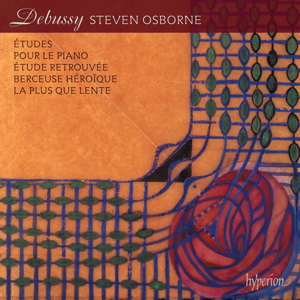
Claude Debussy (1862-1918)
Études L143 (1915)
Pour le piano L95 (1894-1901)
La plus que lente L128 (1910)
Berceuse héroïque L140 (1914)
Étude retrouvée (1915) (early version of L143 No.11, realised by Roy Howat)
Steven Osborne (piano)
rec. 2021/22, St Silas the Martyr, Kentish Town, London, UK
Hyperion CDA68409 [68]
Debussy’s Études are not nearly as popular as Préludes or Images. There is a belief that they are dry, academic, and devoid of independent artistic worth. This recording puts the misapprehension to rest.
At the time, Debussy was making a new edition of Chopin’s Studies. He dedicated his twelve Études to the memory of the Polish composer. As is clear from the titles, each piece addresses a particular pianistic difficulty of “finger gymnastics”. The first set includes the Czerny-inspired five-finger exercise. There follow several explorations of harmonic intervals: double thirds, fourths, sixths and octaves. The last Étude in Book One calls for eight fingers and is supposed to be played without the use of the thumb of either hand. It is a tour de force that involves rapid scales, glissandi, variable time signatures and accurate phrasing. The second book features complex chromaticism, ornamentation, repeated notes, the opposed sonorities of “light and shade,” arpeggios and massive chordal structures.
Debussy noted that the Études must serve as “a useful warning to pianists not to take up the musical profession unless they have remarkable hands”. In the preface to the score, which is meant to discuss fingering, he omits any reference to this problem and suggests: “If you want a thing well done, do it yourself.”
The question that begs itself: are these Études suitable for the recital room, or are the preserve of the conservatoire? They are challenging at every level, and, within the confines of formal exercises, they incorporate much of Debussy’s earlier piano styles, including Impressionism, and his idiosyncratic used of “rhythm, harmony, tone colour and dynamics”. Debussy’s biographer, Edward Lockspeiser, has insisted that the Études are “perhaps the greatest of his piano works […] representing a summary of the composer’s entire pianistic creation”. Steven Osborne’s performance here gives a definite sense that these late piano pieces are artful rather than just academic. There is a perfect fusion of technical prowess and artistic subtlety.
As a little bonus, Osborne has recorded Étude retrouvée, the six-page sketch realised by Roy Howat. This is an early version of the eleventh study, For compound arpeggios. It has little in common with the published study, save the key of A flat, and the use of arpeggios. It abounds with Debussy’s magic.
Pour le piano took several years to complete. The suite has three numbers: Prelude, Sarabande and Toccata. Once again, Debussy has eschewed picturesque titles in favour of something more classical. The stately Sarabande originally written in 1894 was dedicated to Yvonne Lerolle, the daughter of the painter Henri Lerolle. A 1901 reworking for the present suite removed “some slightly obtrusive chromaticisms”. Osborne has recorded the original Sarabande on Hyperion CDA68390. The outer pieces reflect the harpsichord writing of the eighteenth-century composers François Couperin and Jean-Phillipe Rameau. Debussy has brought his own melodic and harmonic language, including the whole-tone scale. The Prelude and the Toccata present, respectively, brilliant bravura figurations and a vibrant perpetual motion.
Some commentators belittle La plus que lente as “one of the least consequential of Debussy’s piano compositions”. This “slower than slow waltz” may have been intended for a projected third volume of Images, never fulfilled. It has an almost Poulencian sense of being “half parody, half earnestness”. It gives the impression of having all the charm of a Parisian café waltz, imbued with a touch of Hungarian Roma flair, and hints of jazz.
The Berceuse héroïque,probably seldom played, has this full title: Berceuse héroïque pour rendre hommage a S.M. le Roi Albert 1 er Belgique et à ses soldiers. It was included in King Albert’s Book published by the Daily Telegraph in 1914. A tribute to the Belgian King and People “from representative men and women throughout the world”, it was designed to raise funds for the embattled nation. It included tributes by Thomas Hardy, Winston Churchill, the Archbishop of Canterbury, Arthur Rackham, and the Aga Khan. There was prose, verse, illustrations, and Debussy’s Berceuse. This is a desolate, war-weary piece, despite the attempt to include the Belgian national anthem in the middle section, which does little to raise the spirits, even with a few “distant fanfares”.
The French music specialist Roger Nichols’s liner notes (in English, French and German) give a splendid insight into all the pieces. There is a resume of Steven Osborne. The cover features an evocative Textile Design (c.1915) by the Scottish architect and designer, Charles Rennie Mackintosh.
Steven Osborne brings technical agility and remarkable interpretative skills to these performances. They are replete with magic, great beauty and a sympathetic understanding. This is complimented by a vibrant recording.
John France
Help us financially by purchasing from



















